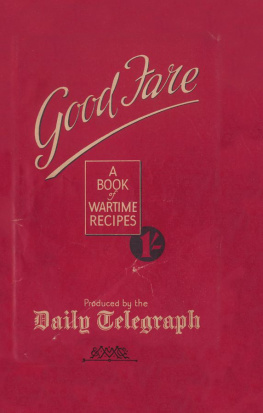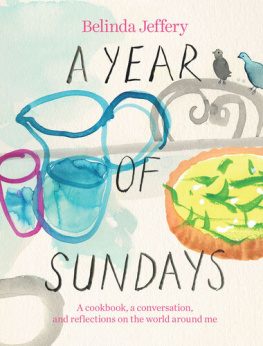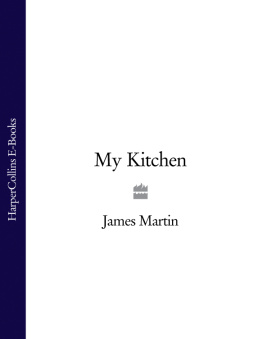GOOD FARE
A BOOK OF WARTIME RECIPES
COMPILED BY
The Daily Telegraph HOME COOK

CONTENTS
CHAPTER
Homely Dishes of the Day |
Butchers Sundries |
Meat Pie Making |
Roots and Greens |
The Conquering Carrot |
PART I
CHAPTER I
SOUP BOWL ECONOMY
QUICKLY prepared soups to fill the soup bowls and covered cups that are now preferred to shallow plates are in request. The old stock-pot essential to the making of so many of the classic soups and the prolonged cooking required have to be ruled out and a new technique followed. Liquid in which vegetables such as potatoes, carrots, turnips, celery, green peas, leeks and so on have been boiled is the basis of many good soups, thick and thin. One vegetable is selected to give predominant flavour; tomatoes, cauliflowers, onions, carrots, green peas are excellent used in this way. Cereals, rice, barley, oatmeal, cornflour, give thickness. Shredded lettuce or cabbage, chopped watercress or sorrel gathered from the fields are suitable additions in some cases.
A little margarine or clarified dripping in which vegetables may be fried lightly adds to the flavour and milk, when available, can be used with vegetable stock. Other ingredients are herbs, fresh from the garden or dried from the store cupboard, nutmeg and mace among spices, and pepper and salt as required. For a brown soup the vegetables are well fried, and meat extract or cubes may be added. Grated cheese may be served separately with any soup. This is a good way of using up stale cheese and improves food value. 1 teaspoonful chopped onion. 1 level tablespoonful cornflour. 2 ozs. margarine. 1 quart water or water and milk. 1 quart water or water and milk.
Pepper and salt, grate of nutmeg. Break cauliflower into small sprays. Boil with onion in water to which a little salt has been added. Drain, rub through sieve, return to pan containing liquid in which cauliflower was cooked. Add margarine, seasoning and nutmeg, simmer for 15 minutes, thicken with cornflour, mixed to a paste with a little stock. 1 onion, 1 carrot, 1 small turnip. cupful celery cut in small pieces. 1 oz. dripping or magarine. dripping or magarine.
Bouquet garni (thyme, parsley, bayleaf tied together) or dried herbs, or chopped mint 2 pints water. pint milk. Seasoning. Soak lentils or peas overnight. Slice vegetables, place in saucepan with lentils, water, herbs and seasoning. Simmer 1 to 2 hours, stir occasionally.
Rub through sieve, keeping back a few pieces of carrot. Reheat soup with milk, stirring in fat. Serve in individual cups with pieces of carrot floating in each cup and mint sprinkled over. TOMATO SOUP teacupful tomato puree. 1 pint veal stock or water. 1 tablespoonful rice. 1 tablespoonful rice.
Salt and pepper. Put stock in saucepan. Season, add rice, grated carrot, tomato puree, and after bringing to boil simmer for 20 minutes or longer. Chopped watercress with a little margarine, green peas, cauliflower or any other vegetable could take the place of tomato puree. Addition of a little milk is an improvement. 2 lettuces shredded. 2 lettuces shredded.
A few spinach leaves. 1 teaspoonful chopped onion. teaspoonful sugar. 2 ozs. margarine. 2 tablespoonfuls bread crumbs.
Pepper and salt to taste. 1 quart water or light vegetable stock. Cook peas with onion, lettuces, and margarine in half the quantity of liquid. When peas are soft, sieve, adding at same time the spinach leaves which have been cooked separately. Their purpose is to make the soup a brighter green in colour, but they are an optional ingredient. Restore all to pan with remainder of liquid, bread-crumbs, seasoning and sugar.
Heat thoroughly. A few whole green peas or a teaspoonful of chopped mint may be added before serving. WATERCRESS CREAM 1 lb. watercress. lb. margarine. 1 pints water or water and milk. 1 pints water or water and milk.
Seasoning to taste. Chop watercress and cook gently in saucepan with margarine. Add mashed potatoes, stirring all the time, and then, gradually, the liquid. Simmer for a few minutes, pass through a hair sieve, season. Heat up. WINTER SOUP 1 lb. carrots. 3 pints water or stock. 1 onion, 1 leek, stickof celery. 2 ozs. dripping. dripping.
Few bacon rinds. 2 tablespoonfuls cooked rice. A pinch each of nutmeg, salt, sugar and mixed herbs, salt and pepper. Prepare vegetables by cutting them into small pieces. Melt dripping in saucepan, put in all the vegetables and bacon rinds. Put on lid and cook gently for a few minutes, shaking the pan to prevent burning.
Then add stock or water, mixed herbs, salt and pepper. Continue simmering gently till vegetables are soft and pulpy. Rub through a sieve and add a pinch of sugar and nutmeg. Return to saucepan to reheat, adding the rice well cooked and dry.
CHAPTER II
CHEAPER FISH MADE INTERESTING
CUT-AND-DRIED plans must have no place in the catering scheme when the housewife goes to the fishmonger. Often it is advisable to try out the less familiar and cheaper kinds of fish, bearing in mind that the most expensive are not necessarily the best.
Home cooks have been content to ring the changes on cod, hake, halibut, fresh haddock, mackerel and herrings among fresh fish, and smoked haddock, kippers and bloaters. These are all good fish, but there are others that might well make more frequent appearance on the family table. Fish new to the ordinary British market have come along recently. Government fresh salted cod, and smoked, fresh cod, open out new problems in the culinary art to the intelligent cook with a bent for research. Both lend themselves to such dishes as creamed fish, pies or cakes, and the popular and economical kedgeree.  The use of a greater variety of vegetables with fish is another direction in which research is well worth while.
The use of a greater variety of vegetables with fish is another direction in which research is well worth while.
In the higher branches of fish cookery much is done with mushrooms, artichoke hearts, asparagus points and the universally popular tomatoes. Home cooks might seek triumphs by way of carrots, parsnips, beetroots, Jerusalem artichokes, spinach and with herbs other than parsley. Cereals, rice and oatmeal are advised; grated cheese, forcemeats, are other suggestions. Herrings and mackerel may be sprinkled with oatmeal before frying or grilling. BAKED BREAM This inexpensive fish, although suitable as main luncheon dish with plain boiled, mashed or fried potatoes, is somewhat overlooked. 1 bream between 1 and 2 lbs.
Margarine or dripping for baking. White sauce, flavouring, seasoning. Do not remove scales but fish should be well washed and carefully cleaned. Dry and bake in hot fat till tender but firm. Baste and turn in cooking, which will require about 25 minutes in moderate oven. Scales and skin are removed before fish goes to table.
Serve with white sauce flavoured with tomato, anchovy, parsley or mixed herbs BLOATER FRITTERS 2 bloaters. 1 tablespoonful grated cheese. Pepper and salt to taste Frying batter Go carefully with salt, as bloaters are often salty. Remove head and skin, split and bone, make into neat fillets. Add cheese and seasoning to frying batter; dip fillets in and fry till golden brown and crisp. CALCUTTA CURRY 1 lb. any white fish. pint milk or fish stock 1 onion. 2 chopped chillies. 1 oz. dripping. 1 teaspoonful flour. 1 dessertspoonful curry powder. 1 teaspoonful curry paste. Salt. Salt.











 The use of a greater variety of vegetables with fish is another direction in which research is well worth while.
The use of a greater variety of vegetables with fish is another direction in which research is well worth while.